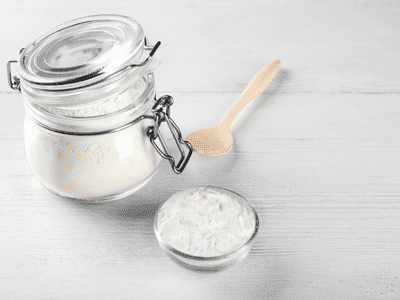Is cornstarch baking powder? In spite of the fact that cornstarch and baking powder appear to be virtually the same thing, they are in fact very distinct from one another.
Baking powder is a more complicated substance that is made up of a number of different components. Acids and bases are the topic of today’s mad scientist discussion, so let’s put on our lab coats and get started. But don’t worry, I won’t damage your brain in any way, I promise!
*By the way, you might also find it interesting to learn that I recently published an article titled “Can You Use Baking Powder Instead of Cornstarch?”
Is Cornstarch Baking Powder?

Corn starch is a common ingredient that is used to thicken sauces, puddings, and pie fillings. It is tasteless, dissolves easily in cold water, and imparts a lustrous sheen to whatever it is used on. Additionally, it can be used to create a golden coating that is paper-thin and crisp when applied to breaded and fried meats. Baking soda and baking powder are not interchangeable because they have completely different chemical compositions and are used for different things in the kitchen.
How Each Is Different

Cornstarch is primarily used as a thickening agent, whereas baking powder is considered to be a leavening agent. This is the primary distinction between cornstarch and baking powder. When combined with other components, they take on an entirely different function.
The kernel of corn contains a naturally occurring carbohydrate known as corn starch. It does not contain gluten and can be used as a flour on occasion; however, the majority of the time, it is utilized for the purpose of thickening. Corn starch can also be used as a remedy for sunburns and rashes, as well as in the production of laundry starch.
Baking powder is a chemical leavener that is typically made with cream of tartar and sodium aluminum sulfate. Cream of tartar is one of the acids that is used. When combined with a liquid, it produces carbon dioxide, which, when introduced into baked goods, results in the formation of bubbles.
Baking powder can be used in place of baking soda in certain recipes; however, because baking powder does not have the same ability to thicken as corn starch, it should not be used in place of corn starch. The ability to impart airiness and lightness to baked goods is the primary benefit offered by baking powder. It is possible that it would produce air bubbles in a pie filling or pudding, but it would not properly thicken the food.
Even though you may hear people talking about both of them interchangeably at times, there is a clear distinction between the two. You can’t simply swap out one for the other because they both work to ensure that whatever you are baking gets nice and airy and fluffy, but you also can’t change the amount of either ingredient that the recipe calls for.
Baking soda is a base, which means that in order for it to leaven something, it needs to be combined with an acidic component, like lemon juice or milk, which are both examples of bases. A metallic flavor is left behind in the baked good if it is not combined with an acid first, which is obviously not the result that anyone wants.
Baking soda requires the addition of another acidic ingredient in order for it to leaven the baking product, whereas baking powder, which is a mixture of baking soda and a dry acid (and sometimes cornstarch), does not require this additional acidic ingredient.
Substitutions

Corn starch can be replaced with arrowroot, granulated tapioca, or flour when you’re in a pinch. Arrowroot can be used in its place, but you will need twice as much tapioca or flour to achieve the same consistency. Keep in mind that the dish will change slightly as a result of using these ingredients, and that the requirements for cooking the dish may also change.
When mixed with cold water, flour, for instance, does not dissolve as easily as corn starch does. Before the addition of liquids, a roux is frequently formed by adding it to butter. If it is not cooked all the way through, it also has the flavor of raw flour.
Recommendations
Tapioca can be used in place of corn starch in puddings and unbaked pie fillings. Baked pie fillings, on the other hand, should be made with flour, arrowroot, or tapioca. When working with corn starch, it is important to avoid over-stirring the mixture or cooking it for an excessive amount of time, both of which can lead to the starch becoming ruined and watered down. Bring it to a boil by cooking it over a heat source of medium intensity. It should be brought to a boil for one minute before being removed from the heat.